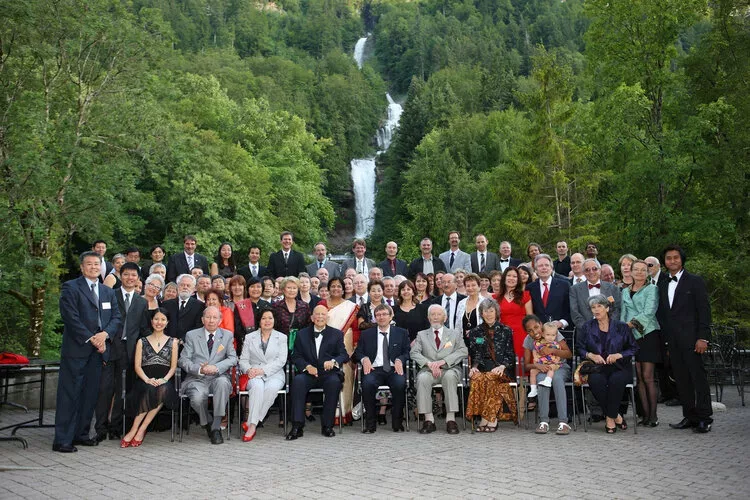Gemmologists
are innovators.
History
The International Gemmological Conference (IGC) owes much of its origin to BIBOA (Bureau International pour la Bijouterie, Orfevrene, Argenterie), the International Jewellery and Gemstone Federation, the first Congress of which in 1926 recommended and defined use of the term cultured pearl.
Experts from various European gem testing laboratories were invited to attend a series of expert meetings that aimed to formulate the policies of BIBOA. In 1936, at the fifth conference of experts, collaboration among laboratories was acclaimed by traders and they encouraged Laboratory Directors to meet each other at a technical conference from which all commercial delegates would be excluded.
Technical meetings were held annually, and in 1951 a Technical Conference was held in Idar Oberstein to prepare for the next London Congress in 1952. Those attending the 1951 conference included Mr B.W. Anderson, Mr G. Gobel, Dr E. Gubelin, Mr F. Wolf, Mr A. Bonebakker, Mr H. Tillander, Mr A. Strondahl, and Mr O. Dragstead. It has been suggested that the future framework of the IGC was established at this meeting in Idar Oberstein.
The London Congress saw the restructuring of BIBOA in which Gemmological Associations were replaced by National Federal Committees, and BIBOA evolved into BIBOAH—the forerunner of CIBJO, now known as The World Jewellery Federation.
A Technical Conference met at Lugano from 23rd to 25th October 1952 at the initiative of Prof. K. Schlossmacher and Dr. E. Gubelin. Also present at this conference were Messrs B.W. Anderson, A. Bonebakker, O. Dragstead, G. Gobel, K. Siess and H. Tillander. At this historic meeting Dr E. Gubelin proposed creation of a “Committee of an International Gemmological Association” that would consist of one member per country; this member being the Director of a Gem Testing Laboratory, or a gemmologist of the calibre who could attend that meeting. This was agreed to, and this meeting was later considered to be the inaugural meeting of the IGC.
The first meeting of the IGC in Lugano was followed by subsequent meetings in Amsterdam (1953), Copenhagen (1954), London (1955), Munich (1956), Oslo (1957), Paris (1958), Milano (1960), Helsinki (1962), Vienna (1964); Barcelona (1966); Stockholm (1968); Brussels (1970); Vitznau, Switzerland (1972); Washington D. C. (1975), The Hague (1977), Idar Oberstein (1979), Kashiko-Jima (1981), Beruwela, Sri Lanka (1983); Sydney, Australia (1985); Rio de Janeiro (1987), Tremezzo, Italy (1989); Stellenboch (1991), Paris, France (1993); Bangkok, Thailand (1995); Idar Oberstein, Germany (1997); Goa, India (1999); Madrid, Spain (2001), Wuhan, China (2004); Moscow, Russia (2007); Arusha, Tanzania (2009), Interlaken, Switzerland (2011); Hanoi, Vietnam, (2013); Vilnius, Lithuania (2015), Namibia (2017), Nantes, France (2019) , Online (2021), Tokyo, Japan (2023) and the 38th will be held in Greece (2025).
Over the history of the IGC, that now in its fourth decade, it can therefore be seen that the International Gemmological Conference is the longest surviving gemmological conference to remain largely in its original format. Over its history, invited delegates representing 33 countries or areas – including Australia, Austria, Belgium, Brazil, Canada, China, Czech Republic, Denmark, England, Finland, France, Greece, Germany, Hong Kong, Israel, India, Italy, Japan, Kenya, Korea, Netherlands, Norway, Russia, Singapore, South Africa, Spain, Sri Lanka, Switzerland, Sweden, Thailand, U.S.A. and Zimbabwe – have been invited to participate in IGC meetings.

Governance
Executive Committee
The day-to-day administration and decision making of the IGC shall be overseen by an Executive Committee that meets formally at IGC meetings, and between meetings conducts the routine business of the IGC electronically by email.
Dr. Jayshree Panjikar, Executive Secretary, India
Dr. Ahmadjan Abduriyim, Japan
Prof. Dr. Emmanuel Fritsch, France
Dr. Anette Juul-Nielsen, Greenland
Dr. Michael Krzemnicki, Switzerland
Dr. Karl Schmetzer, Germany
Mr. Thye Sun Tay, Singapore
Mrs. Willow Wight, Canada
Mr. Gamini Zoysa, Sri Lanka
Dr. J. C. Hanco Zwaan, The Netherlands
